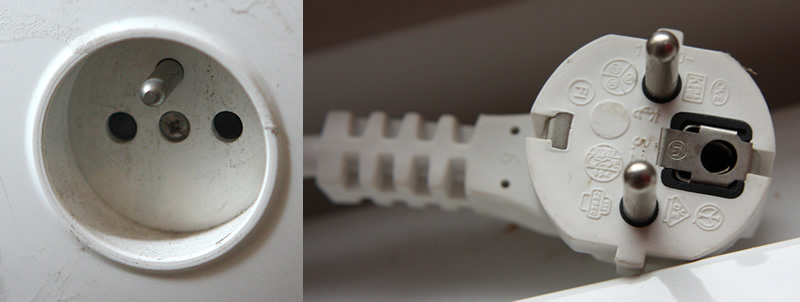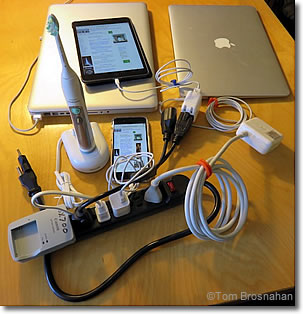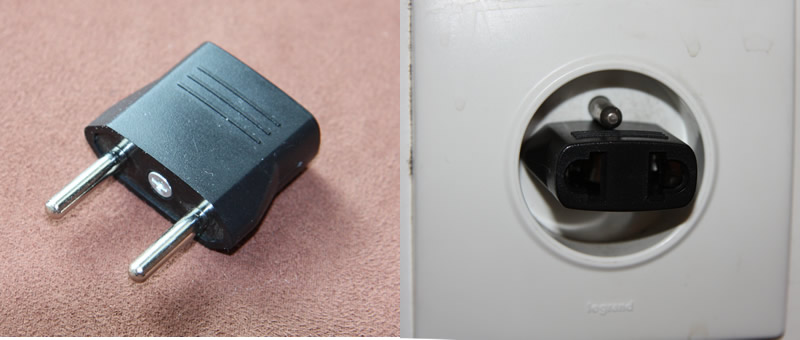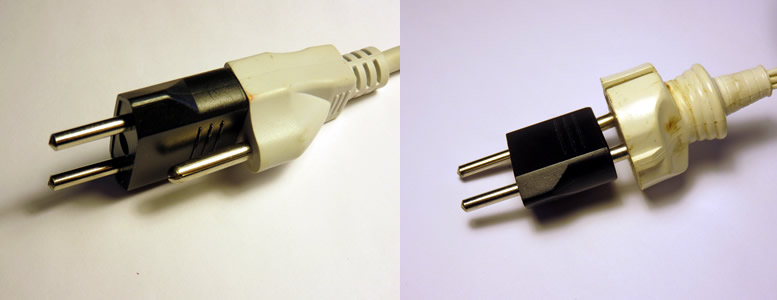French Electric Plugs & Sockets
In most of the world, electrical plugs and sockets (outlets, points) are termed male and female: the male is the one with the prongs, the female with the receptacles for the prongs.French electrical plugs & sockets (points) are different from all others: they're hermaphroditic (prongs in both plug and socket).

Type CEE 7/5 French electrical outlet/point & Type CEE 7/7 plug
Note how the plug has a hole to receive a prong, and the socket/outlet/point has a protruding prong. This is the ground (earth) connection, recommended but not essential for most small appliances. (The ground/earth prong carries no electricity; it acts as a safety in case of a short circuit.)
That means a full-sized plug that will fit a socket in Germany (or any other European country) will not fit a socket in France.
You'll need an adapter to fit Euro, UK and North American plugs into French sockets—and you probably have more than one electrical device (phone, camera, e-book reader, electric toothbrush, etc.) to plug in.
Voltage & Hertz
French electrical current is 220-240 volts, 50-60 Hertz.
Although the voltage in North America, the Caribbean, Japan, some South American and Pacific contries is 100-120 volts, 50 or 60 Hertz, most modern electronic devices (smartphones, tablets, computers, camera and e-watch battery chargers, etc.) can use any voltage from 100 to 240.
Look on the label, or in the device instructions, for the specification. If it includes voltages from 100 or 110 to 240, you can plug it into a French outlet. (If it is rated only at 100-120 volts, you will need a transformer to adapt it to French voltage.)

Note: "Input: 100-240V...50-60 Hz"—Apple iPad Power Adapter usable on both North American and French voltages.
Adapters
A large multi-adapter accepts North American, UK & Euro plugs, and fits into French and other European sockets/points, including the ground/earth connection. Some multi-adapters work in up to 150 differernt countries. This is your most useful solution for your charging station (see below), because it's solid and secure in the wall outlet/point.
Smaller, lighter, simpler adapters for North American and non-French European plugs fit by avoiding the ground/earth prong:
Extension Cords & 3-Socket Cubes
Sometimes in French hotels, B&Bs and apartments, the only electrical outlet available is inconvenient to access—behind the bed or bureau—so you need an extension cord.
Take a 6-foot (2-meter) 2-prong extension cord, connect a 3-socket cube to the single-socket side, and you've got five sockets, three of which are suitable for chargers/power supplies. Add another cube to the cobe and you've got seven!
A simple euro-adapter on the plug end,
and a 3-socket cube on the other: 5 sockets!
Put a 3-prong-to-2-prong adapter on your multi-adapter, plug that into the cord, and you have five plug sockets and two USB ports:
Charging Station
If you're like most travelers on a trip to France, you've got
several electronic devices to charge each day.
Your French hotel room may have only one electrical outlet, and that
in an inconvenient place. Usually, though, there are more outlets
than one, and they aren't all near the floor behind the bed, so if
you have a plug adapter you can charge one device.
When we travel in France to research FranceTravelPlanner.com and
ParisTravelPlanner.com, we need to charge all of the following
devices:
2 Digital cameras
2 Laptop computers
2 Mobile phones
1 Tablet computer
1 Electric toothbrush
1 Kindle book reader
When we arrive in a hotel room, we set up a charging station using a power cord splitter or a power strip.
Power Cord Splitter
A power cord splitter (or power splitter cord) is an electrical wire with a North American plug at one end and two or more North American sockets on separate wires at the other end. Plug the splitter into an adapter in a French outlet, and you've got several independent sockets in which to plug your numerous electrical devices.
A splitter is particularly useful if your devices have extra-large plugs or transformers: there's plenty of room on each independent socket. (This is an advantage over a power strip—see below).
Plug a second splitter cord into one of the sockets and you can have up to seven sockets available; or use the two splitters in different locations in your hotel room or apartment.
Power Strip
A power strip (or power tap) is a device providing multiple sockets/outlets (usually 6 or 8) connected to a cord with a plug on the end. Several devices can be plugged into the power strip. When the plug on the cord is plugged into an electrical outlet, all of the sockets receive electrical current. In effect, a power strip turns one socket/outlet into 6 or 8 sockets—which is what travelers need these days.
With a power strip, you only need one plug adapter: for the plug on the power strip cord. All of your home-country devices are then plugged into the power strip.

Simple power strips/taps—no surge protector circuitry.
Click on the photo for more information & where to find them.
But...Surge Suppressors?
But here's the challenge: most power strips sold in North America and some other countries are also surge suppressors, meaning that they contain electronic circuitry to detect and stop electrical power surges that could damage your electronic equipment. If this electronic circuitry is designed to operate only on North American-standard 120-volt 60-Hertz electric current, and you plug such a surge suppressor into a French outlet which provides 240-volt, 50-Hertz current, the surge suppressor will burn out, or even explode!
We learned this the hard way. The explosion wasn't all that dramatic, but it destroyed the surge suppressor, and thus we didn't have the use of it for the rest of our trip. It was junk. We threw it away.
Hardware and electronics stores usually display many more surge supressors than simple power strips, so shop carefully. Look at the label on the unit itself. If you see the term surge supressor or surge protector on it, and the rating of 110-120 volts, do not use it in France (or in any country that provides 240-volt, 50-Hertz current).
A simple power strip merely connects several plugs to one socket. It contains no electronic circuitry to detect or suppress surges, but in my experience power surges are not a big problem in France.
If the power strip you find includes USB power ports, it may include electronic circuitry intended only for North American 120-volt, 60-Hertz electricity. If so, it will be destroyed if plugged into European 240-volt, 50-Hertz electricity. (The USB ports on the power strip shown below are designed to operate on both 120 and 240 volts.)

A power strip charging station
Power strip with 4 USB charging ports & 3 North American 3-prong plug sockets—and NO surge protection. Rated at 100-240 volts AC, 50/60 Hertz, it's suitable for both North American & European use, so long as you don't need to plug bulky transformers into the main outlets.
Click on the photo for more information.
For more information, and where to buy adapters, power strips and more, click here.
Extension Cord
Power cord splitters and power strips may come with short plug cords, and we often find that we need an extension cord to position our charging station conveniently because power sockets/outlets in French hotels and apartments/flats are not always in convenient locations.
It's worth it to carry at least a 1- or 2-meter (3- or 6-foot) three-wire extension cord to run from the wall outlet to the horizontal surface where you position your charging station and all your electrical devices. (Why three-wire? Because your power cord splitter or power strip will have a three-prong plug on it.)
Click on the photo for details & how to find it.
Consider a longer extension cord—or two of them, especially if you plan to stay in mid-price, budget or historic hotels, B&Bs, or apartments/flats.





